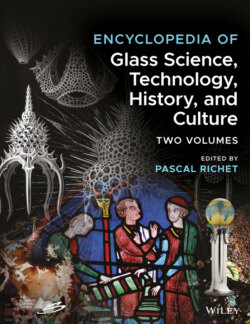Читать книгу Encyclopedia of Glass Science, Technology, History, and Culture - Группа авторов - Страница 320
References
Оглавление1 1 Zachariasen, W.H. (1932). The atomic arrangement in glass. J. Am. Chem. Soc. 54: 3841–3851.
2 2 Bell, R.J. and Dean, P. (1971). The structure of vitreous silica: Validity of the random network theory. Philos. Mag. 25: 1381–1398.
3 3 Landau, D.P. and Binder, K. (2000). A Guide to Monte‐Carlo Simulations in Statistical Physics. Cambridge: Cambridge University Press.
4 4 Allen, M.P. and Tildesley, D.J. (1987). Computer Simulation of Liquids. Oxford: Oxford University Press.
5 5 Woodcock, L.V., Angell, C.A., and Cheeseman, P. (1976). Molecular dynamics studies of the vitreous state: Simple ionic systems and silica. J. Chem. Phys. 65: 1565–1577.
6 6 Takada, A., Catlow, C.R.A., and Price, G.D. (1995). Computer modeling of B2O3: part II. Molecular dynamics simulation of vitreous structures. J. Phys. Condens. Matter 7: 8693–8622.
7 7 Metropolis, N., Rosenbluth, A.W., Rosenbluth, M.N. et al. (1953). Equation of state calculations by fast computing machines. J. Chem. Phys. 21: 1087–1092.
8 8 Greevy, R.L. and Pusztai, L. (1988). Reverse Monte‐Carlo simulation: a new technique for the determination of disordered structures. Mol. Simul. 1: 359–367.
9 9 Kohara, S., Suzuya, K., Takeuchi, K. et al. (2004). Glass formation at the limit of insufficient network formers. Science 303: 1649–1652.
10 10 Vessal, B., Greaves, G.N., Marten, P.T. et al. (1992). Cation microsegregation and ionic mobility in mixed alkali glasses. Nature 356: 504–506.
11 11 Takada, A. and Cormack, A.N. (2008). Computer simulation models of glass structure. Phys. Chem. Glasses: Eur. J. Glass Sci. Technol., B 49: 127–135.
12 12 Soules, T.F. (1990). Stochastic and molecular dynamic models of glass structure. In: Glass Science and Technology, vol. 4A (eds. D.R. Uhlmann and N.J. Kreidl), 267–338. San Diego: Academic Press.
13 13 Johnson, P.A.V. and Wright, A.C. (1982). A neutron diffraction investigation of the structure of vitreous boron trioxide. J. Non Cryst. Solids 50: 281–311.
14 14 Xiang, Y., Du, J., Smedskjaer, M.M., and Mauro, J.C. (2013). Structure and properties of sodium aluminosilicate glasses from molecular dynamics simulations. J. Chem. Phys. 139: 044507.
15 15 Stebbins, J.F. (1991). NMR evidence for five‐coordinated silicon in a silicate glass at atmospheric pressure. Nature 351: 638–639.
16 16 Olivier, L., Yuan, X., Cormack, A.N., and Jäger, C. (2001). Combined 29Si double quantum NMR and MD simulation studies of network connectivities of binary Na2O‐SiO2 glasses: new prospects and problems. J. Non Cryst. Solids 293‐295: 53–66.
17 17 Huang, L., Duffrène, L., and Kieffer, J. (2004). Structural transition in silica glass: thermo‐mechanical anomalies and polymorphism. J. Non Cryst. Solids 349: 1–9.
18 18 Takada, A. (2018). Voronoi tessellation analysis of SiO2 systems based on oxygen packing. J. Non Cryst. Solids 499: 309–327.
19 19 Wright, A.C., Dalba, G., Rocca, F., and Vedishcheva, N.M. (2010). Borate versus silicate glasses: why are they so different? Phys. Chem. Glasses 51: 233–265.
20 20 Ferlat, G., Charpentier, T., Seisonen, A.P. et al. (2008). Boroxol rings in liquid and vitreous B2O3 from first‐principles. Phys. Rev. Lett. 101: 065504.
21 21 Massobrio, C., Du, J., Bernasconi, M., and Salmon, P.S. (2015). Molecular Dynamics Simulations of Disordered Materials. Heidelberg: Springer.
22 22 Takada, A., Parker, J., Durán, A., and Bange, K. (2018). Teaching Glass Better. Madrid: Cyan.
